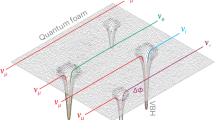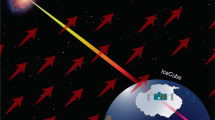Abstract
In addition to its implications for astrophysics, the hunt for neutrinos originating from gamma-ray bursts could also be significant in quantum-gravity research, as they are excellent probes of the microscopic fabric of spacetime. Some previous studies based on neutrinos observed by the IceCube observatory found intriguing preliminary evidence that some of them might be gamma-ray burst neutrinos whose travel times are affected by quantum properties of spacetime that would slow down some of the neutrinos while speeding up others. The IceCube collaboration recently significantly revised the estimates of the direction of observation of their neutrinos, and we here investigate how the corrected directional information affects the results of the previous quantum-spacetime-inspired analyses. We find that there is now little evidence for neutrinos being sped up by quantum spacetime properties, whereas the evidence for neutrinos being slowed down by quantum spacetime is even stronger than previously determined. Our most conservative estimates find a false-alarm probability of less than 1% for these ‘slow neutrinos’, providing motivation for future studies on larger data samples.
This is a preview of subscription content, access via your institution
Access options
Access Nature and 54 other Nature Portfolio journals
Get Nature+, our best-value online-access subscription
$29.99 / 30 days
cancel any time
Subscribe to this journal
Receive 12 digital issues and online access to articles
$119.00 per year
only $9.92 per issue
Buy this article
- Purchase on Springer Link
- Instant access to full article PDF
Prices may be subject to local taxes which are calculated during checkout


Similar content being viewed by others
Data availability
For the GRBs we used the catalogue that can be found at icecube.wisc.edu/~grbweb_public/Summary_table.html. For neutrinos we used the data reported in ref. 20.
References
Amelino-Camelia, G. Quantum-spacetime phenomenology. Living Rev. Relativ. 16, 5 (2013).
Jacob, U. & Piran, T. Neutrinos from gamma-ray bursts as a tool to explore quantum-gravity-induced Lorentz violation. Nat. Phys. 3, 87–90 (2007).
Amelino-Camelia, G. & Smolin, L. Prospects for constraining quantum gravity dispersion with near term observations. Phys. Rev. D 80, 084017 (2009).
Amelino-Camelia, G., Ellis, J., Mavromatos, N. E., Nanopoulos, D. V. & Sarkar, S. Tests of quantum gravity from observations of gamma-ray bursts. Nature 393, 763–765 (1998).
Gambini, R. & Pullin, J. Nonstandard optics from quantum space-time. Phys. Rev. D 59, 124021 (1999).
Alfaro, J., Morales-Tecotl, H. A. & Urrutia, L. F. Quantum gravity corrections to neutrino propagation. Phys. Rev. Lett. 84, 2318–2321 (2000).
Amelino-Camelia, G. & Majid, S. Waves on noncommutative space-time and gamma-ray bursts. Int. J. Mod. Phys. A 15, 4301–4324 (2000).
Myers, R. C. & Pospelov, M. Ultraviolet modifications of dispersion relations in effective field theory. Phys. Rev. Lett. 90, 211601 (2003).
Amelino-Camelia, G., Guetta, D. & Piran, T. Icecube neutrinos and Lorentz invariance violation. Astrophys. J. 806, 269 (2015).
Stecker, F. W., Scully, S. T., Liberati, S. & Mattingly, D. Searching for traces of Planck-scale physics with high energy neutrinos. Phys. Rev. D 91, 045009 (2015).
Waxman, E. & Bahcall, J. N. High energy neutrinos from cosmological gamma-ray burst fireballs. Phys. Rev. Lett. 78, 2292–2295 (1997).
Rachen, J. P. & Meszaros, P. Cosmic rays and neutrinos from gamma-ray bursts. AIP Conf. Proc. 428, 776–780 (1997).
Guetta, D., Hooper, D., Alvarez-Miniz, J., Halzen, F. & Reuveni, E. Neutrinos from individual gamma-ray bursts in the BATSE catalog. Astropart. Phys. 20, 429–455 (2004).
Ahlers, M., Gonzalez-Garcia, M. C. & Halzen, F. GRBs on probation: testing the UHE CR paradigm with IceCube. Astropart. Phys. 35, 87–94 (2011).
Amelino-Camelia, G., Barcaroli, L., D’Amico, G., Loret, N. & Rosati, G. IceCube and GRB neutrinos propagating in quantum spacetime. Phys. Lett. B 761, 318–325 (2016).
Amelino-Camelia, G., Barcaroli, L., D’Amico, G., Loret, N. & Rosati, G. Quantum-gravity-induced dual lensing and IceCube neutrinos. Int. J. Mod. Phys. D 26, 1750076 (2017).
Amelino-Camelia, G., D’Amico, G., Rosati, G. & Loret, N. In-vacuo-dispersion features for GRB neutrinos and photons. Nat. Astron. 1, 0139 (2017).
Huang, Y. & Ma, B. Q. Lorentz violation from gamma-ray burst neutrinos. Commun. Phys. 1, 62 (2018).
Huang, Y., Li, H. & Ma, B. Q. Consistent Lorentz violation features from near-TeV IceCube neutrinos. Phys. Rev. D 99, 123018 (2019).
Abbasi, R. et al. The IceCube high-energy starting event sample: description and flux characterization with 7.5 years of data. Phys. Rev. D 104, 022002 (2021).
Aghanim, N. et al. Planck 2018 results. VI. Cosmological parameters. Astron. Astrophys. 641, A6 (2020); erratum 652, C4 (2021).
Wang, K. et al. Limiting superluminal neutrino velocity and Lorentz invariance violation by neutrino emission from the blazar TXS 0506+056. Phys. Rev. D 102, 063027 (2020).
Aartsen, M. G. et al. Neutrino emission from the direction of the blazar TXS 0506+056 prior to the IceCube-170922A alert. Science 361, 147–151 (2018).
Mészáros, P. Gamma-ray bursts: theoretical issues and developments. Mem. Soc. Ast. It. 90, 57–66 (2019).
Aartsen, M. G. et al. Energy reconstruction methods in the IceCube neutrino telescope. J. Instrum. 9, P03009 (2014).
Xu, H. & Ma, B. Q. Light speed variation from gamma ray burst GRB 160509A. Phys. Lett. B 760, 602–604 (2016).
Ackermann, M. et al. The radio/gamma-ray connection in active galactic nuclei in the era of the Fermi Large Area Telescope. Astrophys. J. 741, 30 (2011).
Vasileiou, V. et al. Constraints on Lorentz invariance violation from Fermi-Large Area Telescope observations of gamma-ray bursts. Phys. Rev. D 87, 122001 (2013).
Acciari, V. A. et al. Bounds on Lorentz invariance violation from MAGIC observation of GRB 190114C. Phys. Rev. Lett. 125, 021301 (2020).
Fiorentini, G. & Mezzorani, G. Solar neutrinos, sunspot number and the magnetic field in the convective zone. Phys. Lett. B 253, 181–184 (1991).
Ludescher, J. et al. Improved El Niño forecasting by cooperativity detection. Proc. Natl Acad. Sci. USA 110, 11742–11745 (2013).
Acknowledgements
G.A.-C. and G.G. are grateful for financial support from the Programme STAR Plus, funded by Federico II University and Compagnia di San Paolo, from FQXi grant no. 2018-190483 and from the MIUR under PRIN 2017 grant no. 20179ZF5KS. The work of G.R. on this project was supported by the National Science Centre under grant no. 2019/33/B/ST2/00050. The work of G.D. on this project was supported by the Research Council of Norway under project no. 301718. This work also falls within the scopes of the EU COST action CA18108 ‘Quantum gravity phenomenology in the multi-messenger era’.
Author information
Authors and Affiliations
Contributions
G.A.-C. proposed the project. All authors contributed to all aspects of the analysis, with G.A.-C., G.G. and G.R. leading the work on pure theory, G.A.-C., G.D. and G.G. leading the work on statistical methods and M.G.D.L., G.G. and G.R. leading the numerical work.
Corresponding author
Ethics declarations
Competing interests
The authors declare no competing interests.
Peer review
Peer review information
Nature Astronomy thanks Anna Pollmann and the other, anonymous, reviewer(s) for their contribution to the peer review of this work.
Additional information
Publisher’s note Springer Nature remains neutral with regard to jurisdictional claims in published maps and institutional affiliations.
Rights and permissions
Springer Nature or its licensor (e.g. a society or other partner) holds exclusive rights to this article under a publishing agreement with the author(s) or other rightsholder(s); author self-archiving of the accepted manuscript version of this article is solely governed by the terms of such publishing agreement and applicable law.
About this article
Cite this article
Amelino-Camelia, G., Di Luca, M.G., Gubitosi, G. et al. Could quantum gravity slow down neutrinos?. Nat Astron 7, 996–1001 (2023). https://doi.org/10.1038/s41550-023-01993-z
Received:
Accepted:
Published:
Issue Date:
DOI: https://doi.org/10.1038/s41550-023-01993-z



